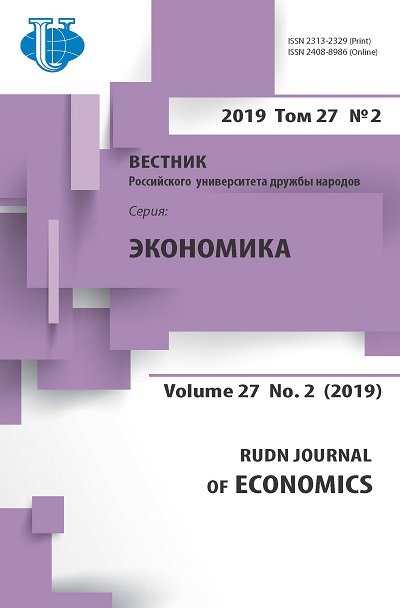The relation of environmental and climatic changes and migration situation in Oceania
- Authors: Ochirova G.N1, Moiseeva E.M1, Maksimova A.S1
-
Affiliations:
- Institute for Socio-Political Studies under the Russian Academy of Sciences
- Issue: Vol 27, No 2 (2019)
- Pages: 313-325
- Section: INTERNATIONAL LABOR MARKET AND INTERNATIONAL MIGRATION
- URL: https://journals.rudn.ru/economics/article/view/22182
- DOI: https://doi.org/10.22363/2313-2329-2019-27-2-313-325
Cite item
Full Text
Abstract
The article presents overview of environmental and climatic, economic and migration situations in the countries of Oceania. In order to determine the relation of environmental and climatic changes and migration processes in the island states and territories of Oceania, New Zealand and Australia, analytical reports and censuses of the population of the states, estimates and statistics of international organizations are studied. The article analyses the state policy of island states and territories in the field of sustainable development and migration, as well as immigration policies of the main host countries such as Australia, New Zealand and the USA. It was found that internal and external migration in Oceania is mainly driven by socio-economic factors (problems with employment, education and medical services), while internal migration is usually directed to urban area, and external - from the city to foreign countries. Exploring the peculiarities of climate change and natural phenomena and their impact on the livelihoods of people in the region of Oceania, we can conclude that natural and climatic influences directly and indirectly affect different spheres of life of the local population. Nevertheless, the impact of climate change and natural phenomena on the migration of the population of Oceania at the moment is insignificant (no more than 10-12% of international flows), however, in the case of an increase in the intensity and frequency of na- tural disasters, and also due to an increase in the number and density of population (71 million people will live in the region to 2100) an increase in the flow of environmental migrants is inevitable.
About the authors
Galina N Ochirova
Institute for Socio-Political Studies under the Russian Academy of Sciences
Author for correspondence.
Email: galinaochirova93@gmail.com
Junior Researcher, Center for Social Demography, Institute of SocioPolitical Research
6 Fotievoy St., bldg. 1, Moscow, 119333, Russian FederationEvgeniya M Moiseeva
Institute for Socio-Political Studies under the Russian Academy of Sciences
Email: evgeniyamoiseeva@mail.ru
Junior Researcher, Center for Social Demography, Institute of Socio-Political Research
6 Fotievoy St., bldg. 1, Moscow, 119333, Russian FederationAnastasiya S Maksimova
Institute for Socio-Political Studies under the Russian Academy of Sciences
Email: lubijizn@yandex.ru
Cand. Sc. (Econ.), Senior Researcher, Center for Social Demography, Institute of Socio-Political Research
6 Fotievoy St., bldg. 1, Moscow, 119333, Russian FederationReferences
- Albert S., Leon J. X., Grinham A.R., Church J.A., Gibbes B.R., Woodroffe C.D. (2016). Interactions between sea-level rise and wave exposure on reef island dynamics in the Solomon Islands. Environmental Research Letters, 11(5), 1–9.
- Barnett J. (2011). Dangerous climate change in the Pacific Islands: food production and food security. Regional Environmental Change, 11(1), 229–237.
- Constable A.L. (2017). Climate change and migration in the Pacific: options for Tuvalu and the Marshall Islands. Regional environmental change, 17(4), 1029–1038.
- Duke M.R. (2014). Marshall Islanders: Migration Patterns and Health-Care Challenges. The Online Journal of the Migration Policy Institute. Retrieved from https://www. migrationpolicy.org/article/marshall-islanders-migration-patterns-and-health-care-challenges
- Dun O., Gemenne F. (2008). Defining “environmental migration”. Forced Migration Review, (31), 10–11.
- Gagnon A.S., Bush A.B.G., Smoyer-Tomic K.E. (2001). Dengue epidemics and the El Niño southern oscillation. Climate Research, 19(1), 35–43.
- Hales S., Weinstein P., Souares Y., Woodward A. (1999). El Niño and the dynamics of vectorborne disease transmission. Environmental Health Perspectives, 107(2), 99–102.
- Hales S., Weinstein P., Woodward A. (1996). Dengue fever epidemics in the South Pacific: driven by El Niño southern oscillation? The Lancet, 348(9042), 1664–1665.
- Hugo G. (1996). Environmental concerns and international migration. International migration review, 105–131.
- Locke J. T. (2009). Climate change‐induced migration in the Pacific Region: sudden crisis and long‐term developments. Geographical Journal, 175(3), 171–180.
- Lukyanets A.S., Manshin R.V., Moiseeva E.M. (2018). Sotsial'no-ekonomicheskiye posledstviya global'nogo izmeneniya klimata dlya stran Afriki yuzhneye Sakhary [SocioEconomic Impacts of Global Climate Change for Sub-Sahar Africa Countries]. Nauchnoe obozrenie. Seriya 1. Ekonomika i parvо, (5), 14–23. doi: 10.26653/2076-4650-20185-02. (In Russ.)
- Lukyanets A.S., Ryazantsev S.V. (2016). Economic and Socio-Demographic Effects of Global Climate Change. International Journal of Economics and Financial Issues, 6(8S), 268–273.
- Lukyanets A.S., Toan Khanh Nguen, Ryazantsev S.V., Tikunov V.S., Hai Hoang Pham (2015). Influence of climatic changes on population migration in Vietnam. Geography and Natural Resources, 36(3), 313–317. doi: 10.1134/S1875372815030129
- Piguet E. (2010). Linking climate change, environmental degradation, and migration: a methodological overview. Wiley Interdisciplinary Reviews: Climate Change, 1(4), 517–524.
- Warner K., Hamza M., Oliver-Smith A., Renaud F., Julca, A. (2010). Climate change, environmental degradation and migration. Natural Hazards, 55(3), 689–715.















